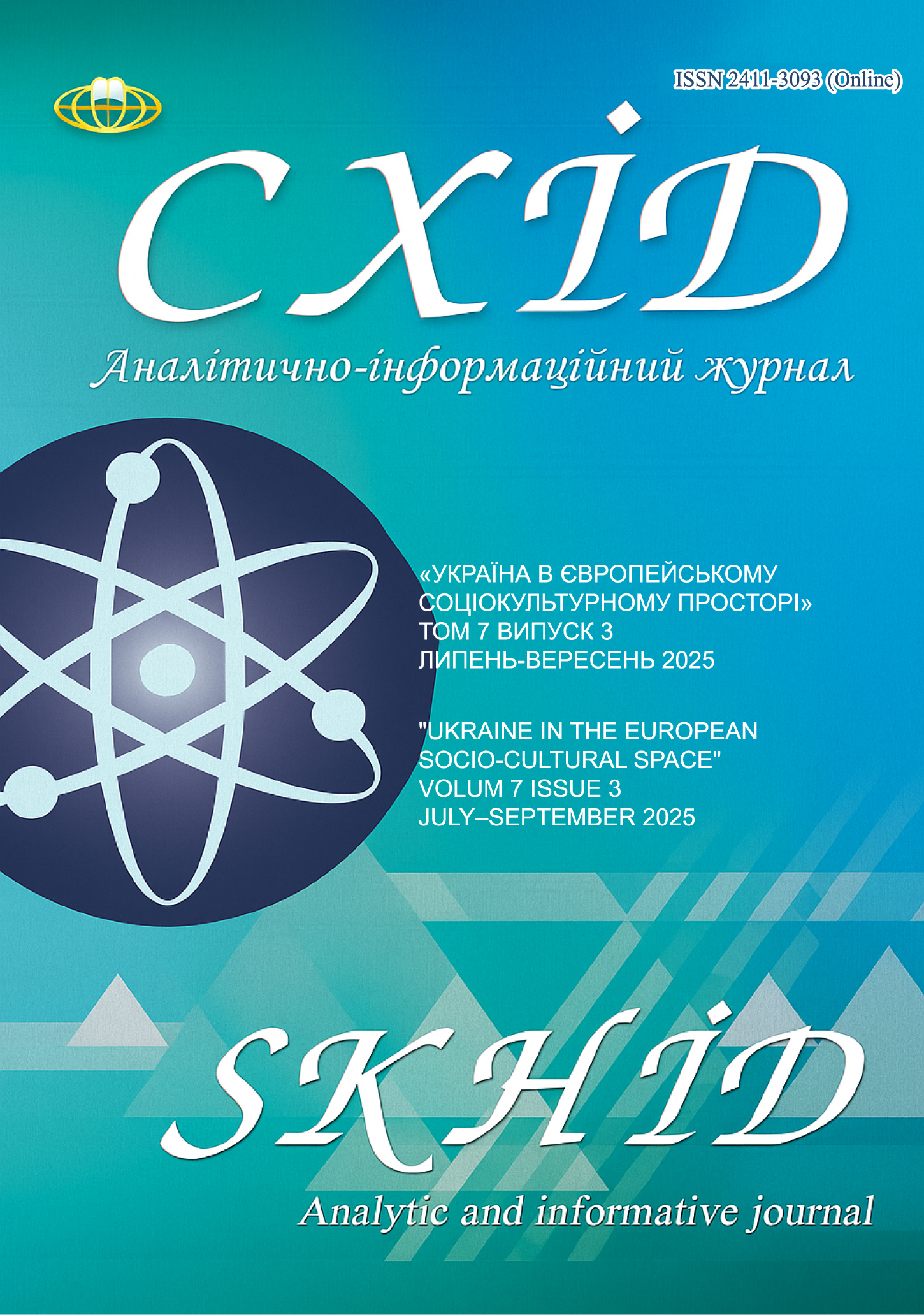European integration course of Ukraine: implementation of national interests and current challenges
DOI:
https://doi.org/10.21847/2411-3093.2025.738Keywords:
European integration, Ukraine’s foreign poli-cy, national security, EU–Ukraine relations, international relations, reforms, Association AgreementAbstract
This article examines Ukraine’s European integration course as one of the main directions of contemporary foreign policy and a crucial mechanism for strengthening national security, ensuring sustainable development, and modernizing the state. It traces the historical evolution of Ukraine–EU relations, starting with the 1990 Declaration of State Sovereignty, the 1993 Verkhovna Rada Resolution “On the Main Directions of Ukraine’s Foreign Policy,” and the signing of the 1994 Partnership and Cooperation Agreement, and culminating in the granting of EU candidate status in 2022. The paper reviews key legal and institutional frameworks, including the Ukraine–EU Action Plan, the European Neighbourhood Policy, the Eastern Partnership initiative, the Association Agreement, and the establishment of the Deep and Comprehensive Free Trade Area. Particular attention is paid to the transformation of European integration following Russia’s full-scale invasion of Ukraine in 2022, which turned EU accession from a political and economic project into a strategy for survival, recovery, and security consolidation. The study analyzes the economic, political, and security dimensions of integration, focusing on the harmonization of Ukrainian legislation with EU law, modernization of state institutions, promotion of democratic reforms, and the prospects for accession negotiations in 2025. Key obstacles to integration are identified, including insufficient competitiveness of certain economic sectors, difficulties in meeting financial obligations, and the need to improve the professional capacity of civil servants. The article highlights the EU’s role as a strategic partner in security cooperation, including Ukraine’s participation in PESCO and EUMAM initiatives and the signing of bilateral security agreements. The findings emphasize that Ukraine’s European integration course is a comprehensive strategy aimed at establishing the country as an integral part of the European political, economic, and security space, strengthening its international position, and improving citizens’ quality of life.
Downloads
References
European Commission. Ukraine Facility 2024–2027. September 11, 2025. https://surl.li/rljrqb
European Union External Action. (2021, October 11). Facts and figures about EU-Ukraine relations. https://euneighbourseast.eu/wp-content/uploads/2021/10/ua_factsheet_11-10-2021_eng.pdf
Freedom House. (2024). Ukraine: Nations in Transit 2024 Country Report. https://freedomhouse.org/country/ukraine/nations-transit/2024
Horiunova, Y. (2022). Foreign policy strategy of Ukraine in the context of the Russia-Ukraine war. Amazonia Investiga, 11(60), 75–89.
Klymenko, I., Kharazishvili, Yu., Sharov, O., & Vus, I. (2013). Ukraine in the integration processes in the post-Soviet space: modelling alternatives. Kyiv, NISD. (In Ukrainian)
Lavrenko, Yu. (2017). Legal foundations of Ukraine's European integration: problems, challenges and prospects. In: Legal foundations of Ukraine's Euro-pean and Euro-Atlantic integration: achievements and prospects: materials of the correspondence sci-entific and practical conference (October 31). Lviv, Lviv Polytechnic: 64–68. (In Ukrainian)
Matyushenko, I., Berenda, S., & Reznikov, V. (2015). Ukraine's European integration in the system of international economic integration: a textbook. Kharkiv, V. N. Karazin Kharkiv National University. (In Ukrainian)
Pavlenko, I. (2022). Institutional capacity of public au-thorities in the process of Ukraine's European integration. Scientific Notes of the Institute of Legislation of the Verkhovna Rada of Ukraine, 6, 35–42.
Pipchenko, N., Makarenko, I., Ryzhkov, M., & Zaitseva, M. (2021). The policy of European and Euro-Atlantic integration as a key factor for Ukraine’s transformation. European Spatial Research and Policy, 28(1): 265–285.
President of Ukraine. (1998, 11 June). On the approval of the Strategy for Ukraine's integration into the European Union: Decree of the President of Ukraine No. 615. https://zakon.rada.gov.ua/laws/show/615/98
Representation of Ukraine to the European Union. Over-view of Ukraine-EU relations. https://ukraineeu.mfa.gov.ua/posolstvo/zagalnij-oglyad-vidnosin-ukrayina-yes
Roshko, S., & Rivis, O. (2024). Ukraine's current Europe-an integration strategy. In World economy and civili-sational progress amidst polystructural changes: economic-technological, resource, political-legal, security-social factors: conference proceedings (16–17 April 2024, Uzhhorod, Ukraine). Riga, Latvia, Baltija Publishing: 100–104.
Saienko, Yu., & Lytvynenko, O. (Eds.). (2022). Current transformations in public policy: national and international dimensions. Kyiv, Razumkov Centre. https://surl.li/thugnw
SSRN. (2017). European Integration of Ukraine: Tool for Internal Reform, Source of Problems or Pass Ticket to EU Membership? https://papers.ssrn.com/sol3/papers.cfm?abstract_id=2983789
Stepanenko, N., & Stepanenko, V. (2018). Ukraine's integration into the European Union: advantages and disadvantages. Bulletin of Transport and Industry Economics, 61: 62–67.
Suspilne. (2025, 11 September). In 2025, the European Union (EU) will provide Ukraine with €35 billion in financial assistance under the G7 ERA initiative and the Ukraine Facility programme. https://suspilne.media/931367-evrosouz-nadast-ukraini-35-mlrd-finansovoi-dopomogi/
Verkhovna Rada of Ukraine (2019). Constitution of Ukraine: Law of Ukraine on Amendments to the Constitution of Ukraine (regarding the strategic course of the state towards Ukraine's full membership in the European Union and the North Atlantic Treaty Organisation). https://zakon.rada.gov.ua/laws/show/2222-15
Downloads
Published
How to Cite
Issue
Section
License
Copyright (c) 2025 Єлизавета Пєтухова

This work is licensed under a Creative Commons Attribution-NonCommercial-NoDerivatives 4.0 International License.
1. Authors bear responsibility for the accuracy of facts, quotations, numbers and names used.
2. Manuscripts are not sent back.
3. The publisher does not always agree with the authors' opinion.
4. The authors reserve the right to authorship of the work and pass the first publication right of this work to the journal under the terms of a Creative Commons Attribution-NonCommercial-NoDerivatives 4.0 International License. This license allows others to distribute (copy) the published work for non-commercial purposes, provided there is mandatory attribution to its authors and a link to the first publication in our journal.
5. The authors have the right to conclude separate supplement agreements that relate to non-exclusive work distribution in the form in which it has been published by the journal (for example, to upload the work to the online storage of the journal or publish it as part of a monograph), provided that the reference to the first publication of the work in this journal is included.

